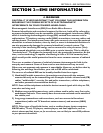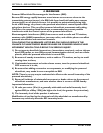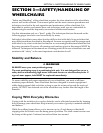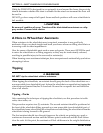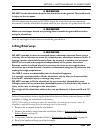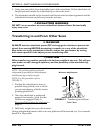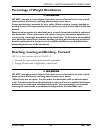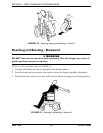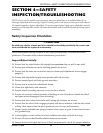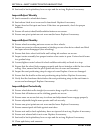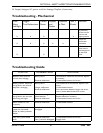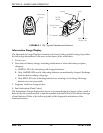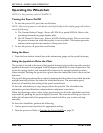
SECTION 4—SAFETY INSPECTION/TROUBLESHOOTING
Part No. 1118386 25 P9000
™
XDT
SECTION 4—SAFETY
INSPECTION/TROUBLESHOOTING
NOTE: Every six (6) months or as necessary take your wheelchair to a qualified dealer for a
thorough inspection and servicing. Regular cleaning will reveal loose or worn parts and enhance
the smooth operation of your wheelchair. To operate properly and safely, your wheelchair must be
cared for just like any other vehicle. Routine maintenance will extend the life and efficiency of your
wheelchair.
Safety Inspection Checklists
ࣼ CAUTION
As with any vehicle, wheels and tires should be checked periodically for cracks and
wear and should be replaced as necessary.
Initial adjustments should be made to suit your personal body structure needs and
preference. Thereafter follow these maintenance procedures:
Inspect/Adjust Initially
❑ Ensure that the wheelchair rolls straight (no excessive drag or pull to one side).
❑ Ensure that all fasteners on the clothing guards are secure.
❑ Ensure that the arms are secure but easy to release and adjustment levers engage
properly.
❑ Ensure that adjustable height arms operate and lock securely.
❑ Ensure armrest pads sit flush against arm tubes.
❑ Ensure seat is secured to wheelchair frame.
❑ Clean seat upholstery and armrests.
❑ Ensure wheel mounting nuts are secure on drive wheels.
❑ Ensure no excessive side movement or binding occurs when drive wheels are lifted
and spun when disengaged (free-wheeling).
❑ Ensure that drive wheel axle bolts and locking tab washers are secure.
❑ Ensure that the wheel locks engage properly and do not interfere with the tires when
rolling. Also, ensure that the pivot points are free of wear and looseness.
❑ Inspect caster assembly has proper tension when caster is spun. Caster should come
to a gradual stop.
❑ Loosen/tighten caster locknut if wheel wobbles noticeably or binds to a stop.
❑ Ensure all caster/wheel/fork/headtube fasteners are secure.
❑ Inspect tires for flat spots and wear. If tires are pneumatic, check for proper inflation.



